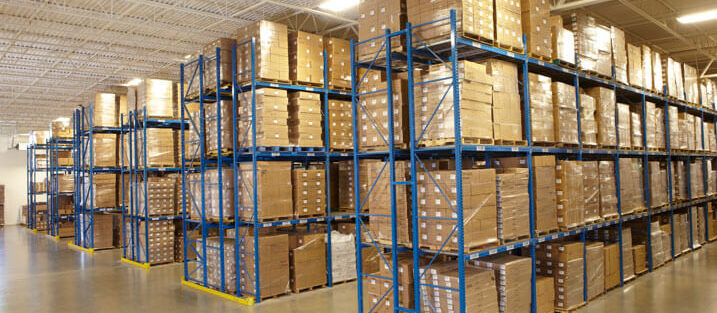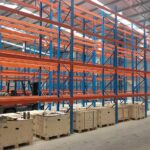Today I would like to talk about pallet racking; what it is, its components and what damage to look for when inspecting your rack. I may not be an “official” pallet racking inspector, but for the last 10 years I have worked in the design and implementation of pallet racking projects Australia wide, as well as being part of a team or committee where racking inspection and recommendations have been made available to customers who are not sure what to look for when it comes to assessing their installed pallet racking. Long story short, I’ve seen lots of racks over the years.
Most warehousing operations have a close, if not essential, relationship with their pallet racking. For many businesses in Australia, and across the world, pallet racking represents the backbone of their operation, and because this link between rack and businesses is so close together, it is hard for me to understand why there are still companies out there that pay little to no-attention to the proper maintenance of their racks. Even worse, some are reluctant not only to maintain it, but also to replace the racks when its state has surpassed its life-cycle and safe working conditions. I probably haven’t seen it all, but over the years I’ve seen some F(rack)ensteins, with some degree of ingenuity but also a risk factor in the border of catastrophic.
Some of you may be asking, what is pallet racking? What are its major components? Why is it so important to maintain the racks in good shape? Well, let’s start with the what.
Pallet racking, in its more generic form, is an assembly of components that are fabricated from thin laminated steel (of various gauges and strengths, depending on the manufacturer) designed to form a multilevel structure, capable of withstanding mostly vertical and other minor horizontal forces. The major components of selective pallet racking are:

- Beams: These horizontal “bars” are generally painted in bright colours to make positioning of products at height easier. Beams are designed to form levels (in pairs) to place pallets directly on top of them or to form other type of storage. Beams work better with vertical loads and have some degree of lateral resistance to impacts. Operators should take care not to collide with the beams as dents reduce its structural capacity and replacement may be required. The most common types of beams for pallet racking applications these days are Box and Open beams, other types include “I” beams, stepped beams, among others.
- Frames: Frames are assemblies that form the column of the racks. These are composed of:
- Uprights: These are long, boxy shaped elements that have great vertical capacity and are designed for the beams to be connected to, to form levels. Uprights are the backbone of pallet racks; frequent impact and excessive deformation of uprights is the most common cause of racks collapsing. Although collapsing is not as common, never disregard that possibility if you have a poorly maintained rack.
- Bracing: Braces are thin bars that connect to the back of the uprights to link them together and form the frame. Bracing provides structural strength to the uprights and its triangular shaped pattern prevent rotation, keeping uprights levelled.
- Baseplates: Baseplates are connected to the bottom of the uprights for the whole structure to be fixed to the ground, preventing the racks from moving freely when pallets are positioned or removed from the levels. Damage to baseplates may translate to damage to uprights but it is not always the case. Baseplates come in different shapes and its connection to uprights vary depending the manufacturer.
Now that we have seen what selective pallet racking is about, let’s discuss the importance of keeping it in good working condition. As mentioned above, pallet racking components are strong and durable but thin. This last factor makes its components susceptible to lateral, and frontal, impact and deformation. Excessive deformation or repetitive impact to its components weakens the structure and increases the risk of collapsing and injuring people working around (or even worse in some instances). So, what should you look for? Below is a brief list of things you can look out for when inspecting racks:
- Signs of impact such as dents and deformation of major components.
- Corrosion and peeled paint.
- Loose bolts and nuts.
- Broken connections of any of its components.
- Baseplates not properly fixed to the ground or anchors sheared due to impact.
It is also important to strive for compliance. The Australian Standard for Pallet Racking Systems, AS4084:2012, mandates the following minimum standards for your rack to comply with racking safety regulations (for more detailed information consult the standard or contact us):
- Baseplates fixed to the ground with a minimum of two anchors.
- Safe Working Load Signs positioned at the ends of the racks. These are issued by the manufacturer, or racking specialist, who can certify that the rack is structurally sound. Information such as the maximum loads per level and the maximum overall pallet racking bay capacity can be found in these. There is other required information to be found in these signs, but these are the most relevant ones to ensure the racking is not overloaded.
Other things you may consider that make your rack safer and long-lasting include (but not limited to):
- Install Rack End Protectors to protect, as its name states, the end of the rack. The last frame of the rack is the most vulnerable and exposed to impact, therefore, highly recommended.
- Install upright protectors, especially in very busy environments. These elements reduce damage to uprights when people accidentally drive into them.
- Install mesh-decks on beam levels where non-Australian standard pallets are stored such as Euro pallets, NZ pallets, plastic pallets (especially for plastic ones, unless a slave pallet is positioned right under), and other type of pallets that are not designed to work in Australian rack. Australian standard pallets are 1,165mm x 1,165mm, with bottom boards that “lock” the pallet between beams and prevent it from sliding, back or forth, on the beams.
- Fall mesh protection or other mechanism that prevents product, or pallets, from falling at the back of the racks. This is especially recommended when there is a pedestrian crossing under the rack or single framed runs of rack with pedestrian walkways behind.
Remember that everything has a lifecycle, and that includes the pallet racking in your warehouse. Recommended working life span for pallet racking varies depending on the manufacturer; some come with 20+ years, others lifetime warranties. However, these numbers may vary depending on how good or bad the structures are treated (I’ve seen brand new, just-installed racks in need of critical member replacements within days of installed). Also, some of these manufacturers’ warranties depend on an agreement for the installer to inspect the racks at least once a year.
As a final note, periodic scheduled maintenance and replacement of damaged, or too old, components will ensure your racks will be in good working condition and will provide a safe environment for those working around them. It is important to engage a pallet racking auditor who can perform a certified audit of your warehouse.





